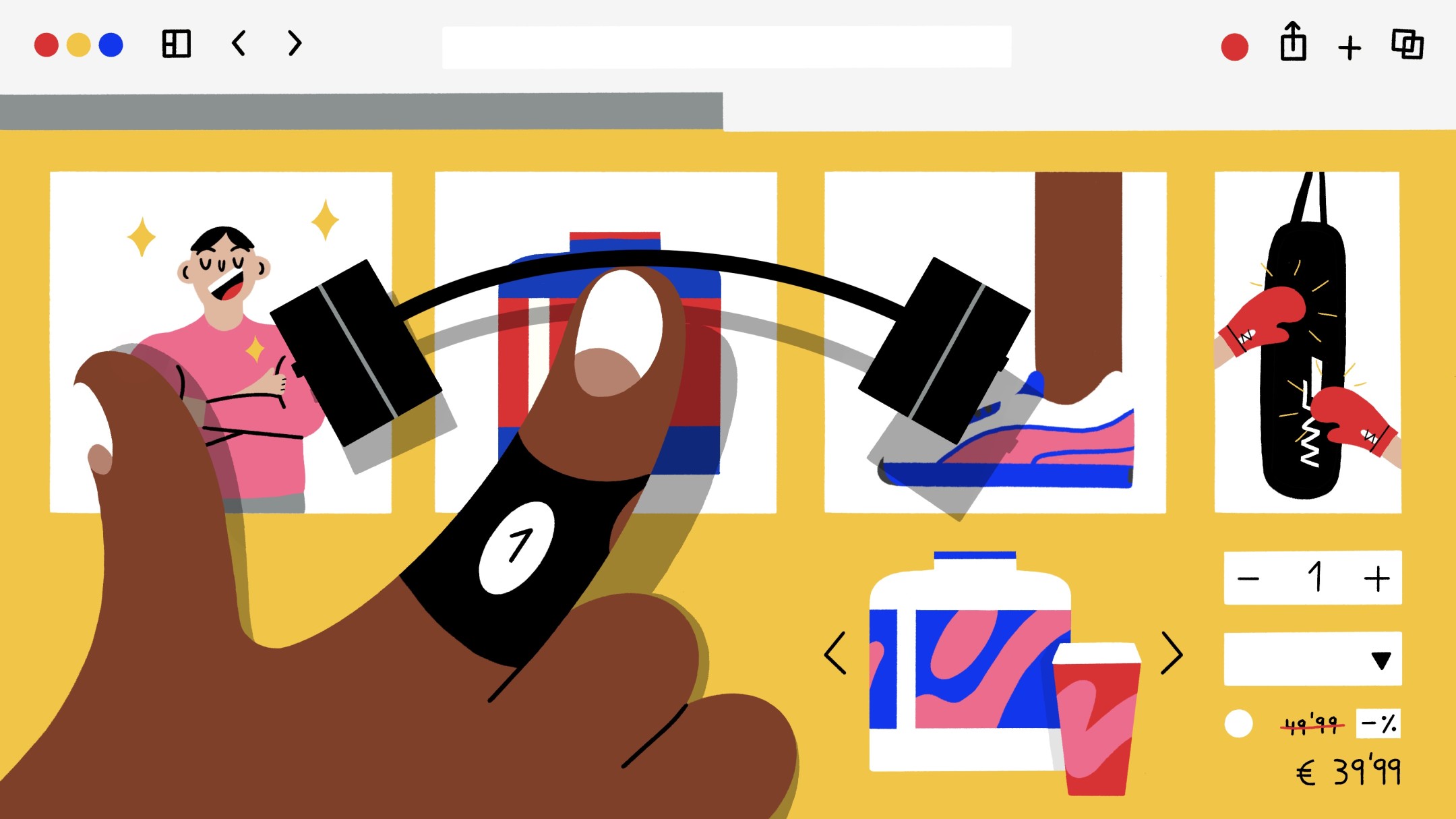To say the fitness ecommerce industry is jacked would be an understatement.
- Boxraw hit £5.2 million ($7 million) in sales in 2020 and intends to double its 39-person team in 2022.
- After Crossrope replatformed to Shopify Plus during the COVID-19 pandemic, the brand saw a 90% increase in revenue and a 94% boost in transactions.
- Active Truth’s site migration increased conversion rates by 50% and doubled its site visitors.
Worth nearly $160 billion in 2021, the fitness industry is expected to grow 172%, to $435 billion by 2028 (with much of this growth attributed to the online/digital fitness industry).
The COVID-19 pandemic has affected parts of the fitness industry disproportionately:
- The gym, health club, and boutique fitness studio industries declined nearly 59% during the COVID-19 pandemic but are recovering as restrictions loosen.
- Meanwhile, the online/digital fitness, fitness apps, fitness equipment, and fitness tracker markets experienced revenue growth of 40% in 2020 and are projected to rise 66% by the end of 2021.
Of course, market growth is both a blessing and a curse. With opportunity comes competition—fierce competition.
It also reflects a larger trend in commerce itself: brands that don’t go digital might as well gohome. To help guide you, we’ve rounded up 15 of the most cutting-edge and high-growth fitness ecommerce brands.
- Gymshark
- Crossrope
- BPI Sports
- Altitude Sports
- 310
- NOBULL
- Boxraw
- Women’s Best
- Campus Protein
- Sweetlegs
- GuardLab
- Fabletics
- Active Truth
- Mava Sports
- Kayla Itsines
1. Gymshark: from URL to IRL
How do you build an army of millions of loyal customers across 131 countries?
If you’reGymshark, first, you create a multi-channel online presence that spans social networks and onsite experiences with a consistent brand aesthetic.
The kind of presence that gets you a shout-out from Cheryl Samberg during a Facebook earnings call. (No, really!)
Then, you bring that online experience, offline … into the real world.
Gymshark has mastered the art of online-to-offline (O2O) commerce through internationalpop-up shops. These pop-ups include meet-and-greets with some of the most popular fitness experts and influencers, and sell merchandise IRL.
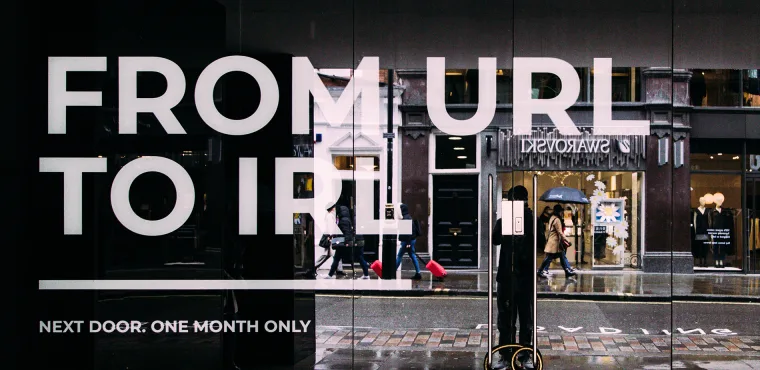
“It’s a customer experience second to none,” says Daniel Knight, Gymshark’s Website Manager. “It bridges the gap between the digital and physical worlds and creates emotional customer experiences that can’t be had online alone.”
2. Crossrope: replatforming on the move
Can you build a fitness program and brand around jump ropes?Crossropedid, and the brand is growing exponentially—during COVID-19, no less. When the pandemic hit and people were forced to exercise from home, the Crossrope team saw an opportunity to expand its customer base and market its simple at-home workout.
The Crossrope routine caught fire and entered a period of intense sales. However, the team wasn’t confident in their ecommerce platform’s ability to scale with the demand.
“While it was risky to re-platform during a period of intense sales demand … the risk paid off, and today we’re optimized for incredible international growth,” says Chief Marketing Officer Srdjan Popovic. With Shopify Plus, Crossrope saw a 90% increase in revenue and a 94% boost in transactions.
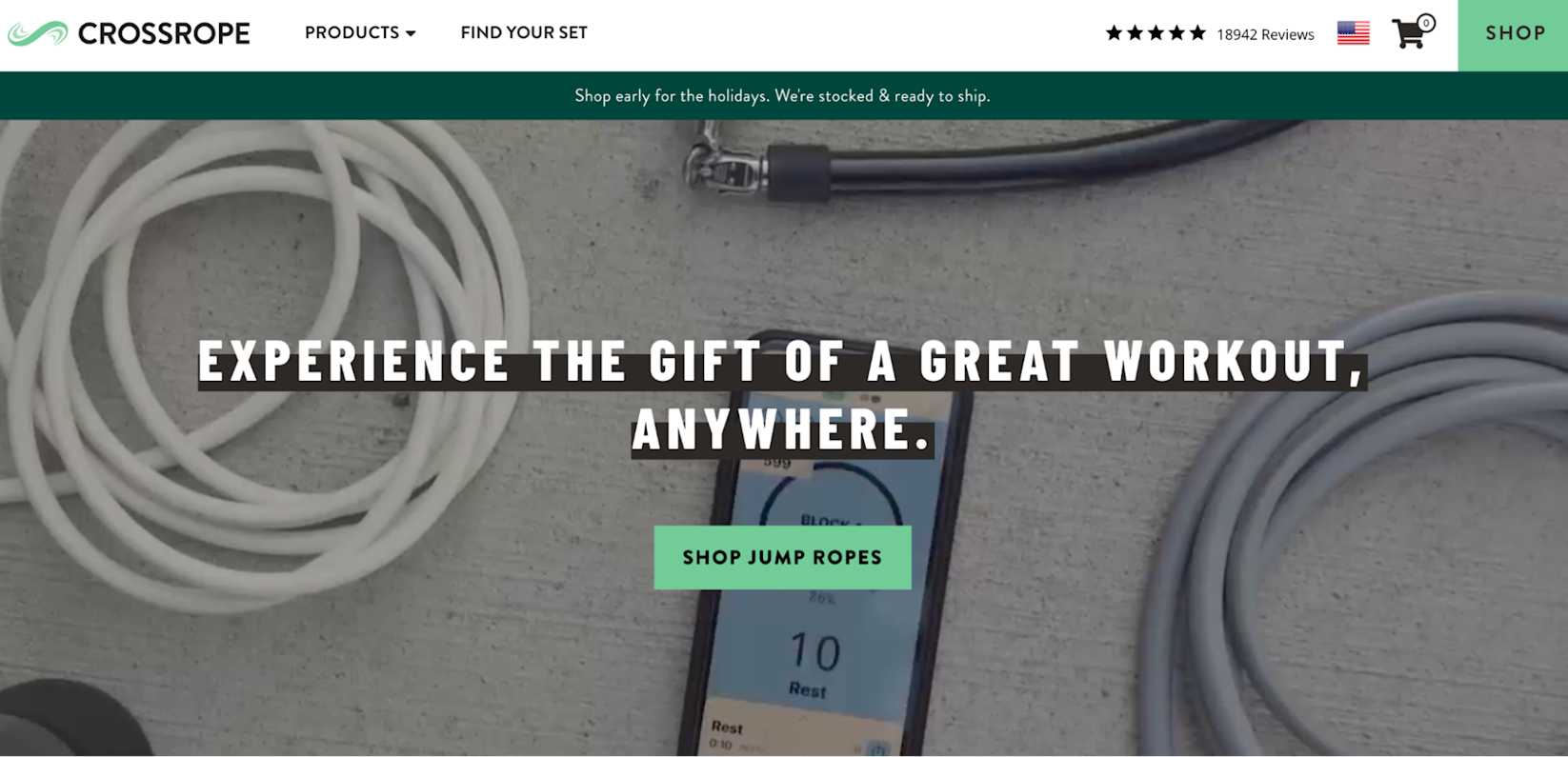
The takeaway? There’s never a perfect time to invest in the future success of your ecommerce company. Whatever growing pains your business is experiencing, don’t let them stop you from preparing for explosive growth down the line. Who knows? A major change may be what you need tocatalyzethat growth.
3. BPI Sports: boosting its D2C presence
Today,BPI Sportsproducts can be found on the shelves of every fitness brand’s dream retailers: GNC, Vitamin World, and The Vitamin Shoppe—just to name a few. The Florida-based nutritional supplement brand is well established as a wholesale company, with its B2B sales accounting for most of its annual revenue.
Yet, BPI Sports wanted to strengthen its D2C channel. The team also wanted to improve the BPI Sports brand identity and be more than just a product you see on another store’s shelf.
The company had a website, but it cost over $6,000 for development fees and provided a poor experience for both customers and employees: shopping carts often crashed and important customer data was unreliable.
“当你增长如此之快,你想汁液t keep pushing, pushing, pushing—and then you’re at a point where your business is overgrowing your infrastructure,” says Oliver Haroun, BPI Sports’ Director of Technology.
To level up, BPI Sports had to change direction. Instead of leaning further into its previous platform, the team decided to simplify their D2C channel with Shopify Plus.
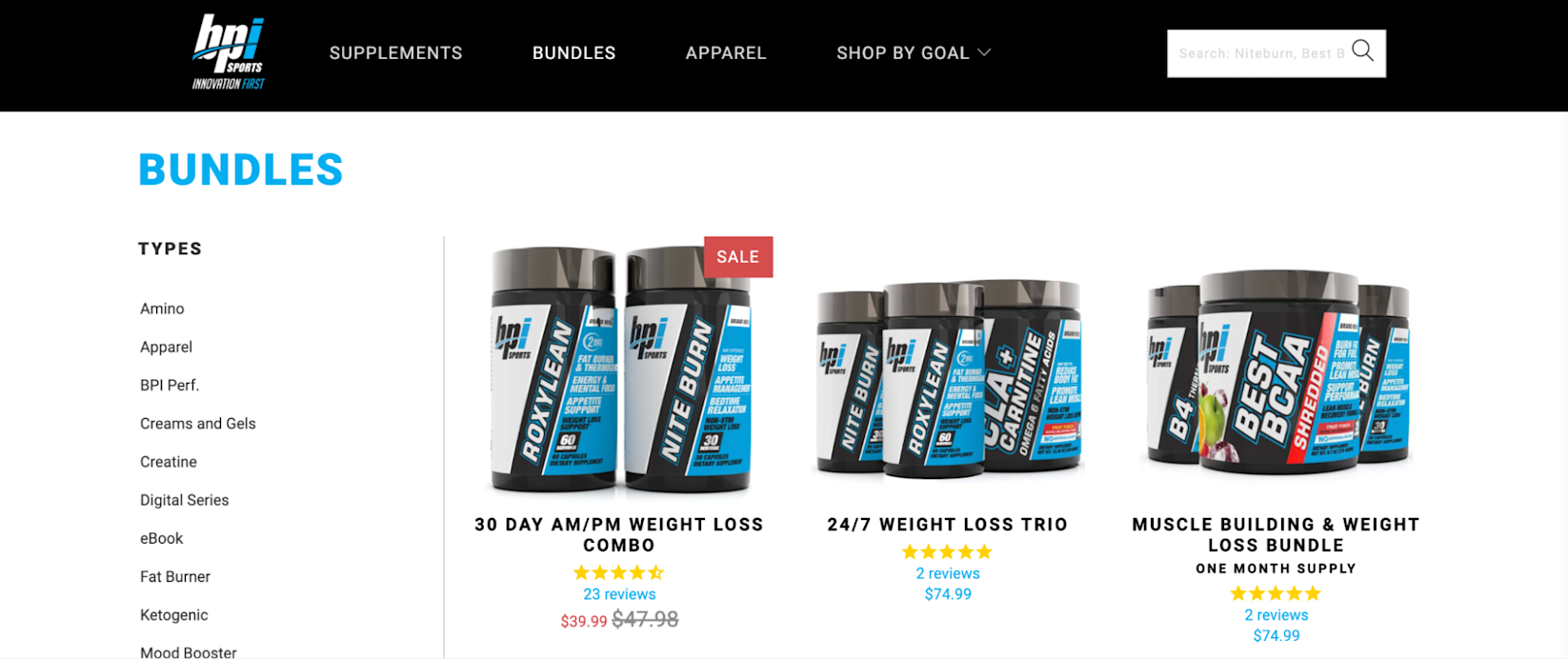
Not only was the team able to fully trust their new ecommerce platform, but they were also able to perform feature testing, make website changes without a developer’s help, and offer a greater variety of products and bundles.
Now, BPI Sports dominates both as a wholesaler and D2C ecommerce company.
4. Altitude Sports: predictive search with visual features
Altitude Sportsstarted as a brick-and-mortar shop in Montreal in the 1980s. Nearly four decades later, the outdoor equipment and clothing company is now a multi-million-dollar ecommerce mega-hub.
What makes Altitude Sports so successful? The brand has been open to the evolution of the digital world.
Most retailers that opened brick-and-mortar stores before the web failed to properly leverage ecommerce. Instead, they relied on word-of-mouth and foot traffic to continue growing their brand.
However, Altitude Sports decided to join the website revolution and launch its ecommerce site in 1999. Since then, it’s continued to grow and evolve alongside technology—not against it.
One of the most innovative features on the Altitude Sports website is its predictive search feature. Using SearchSpring, the site can auto-suggest items based on what customers type in the search bar. The search also offers visual merchandising features so visitors to the site can see their options before clicking.

If you're looking to choose the right search function for your ecommerce business,check out this articleto help guide you through the right questions to ask and what features to look for.
5. 310: fueling community, one supplement at a time
With over a million followers across Facebook and Instagram—415,000 of whom are part of the brand’s closed Facebook group—310has built a thriving online community to empower its members through the highs and lows of getting healthy and fit.
When you’re trying to get healthy or change your eating habits, it’s easy to feel like we have to give up treats. By sharing recipes for treats like theBanana Split ShakeorCinnamon Roll Shake, as well as smoothies for everyholidayand season of the year, 310 helps its community feel equipped and empowered to make healthier decisions without giving up what they love.
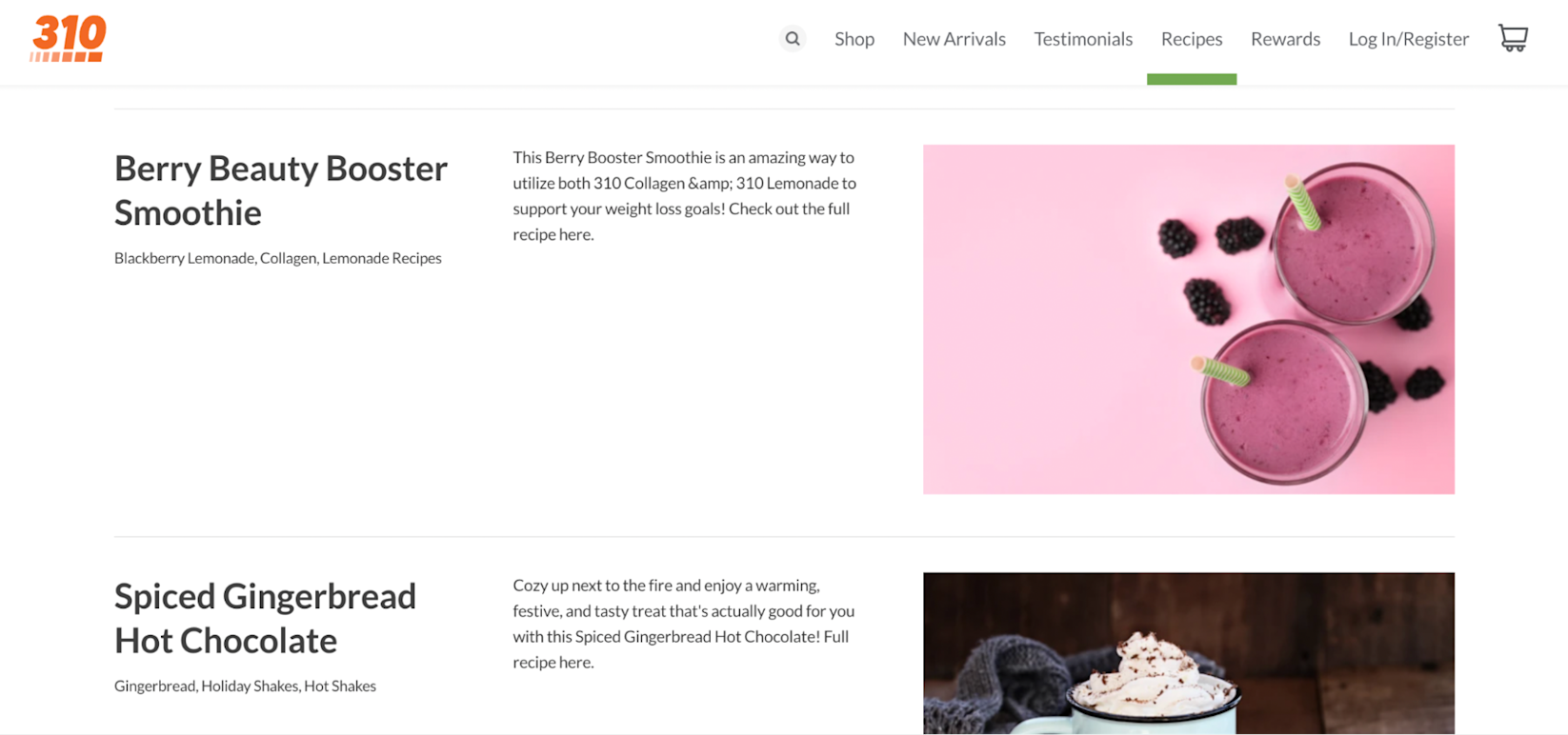
Even more than that, 310’s website and campaigns are full of user-generated content: success stories, testimonials, and before-and-after photos to showcase real results from real people.
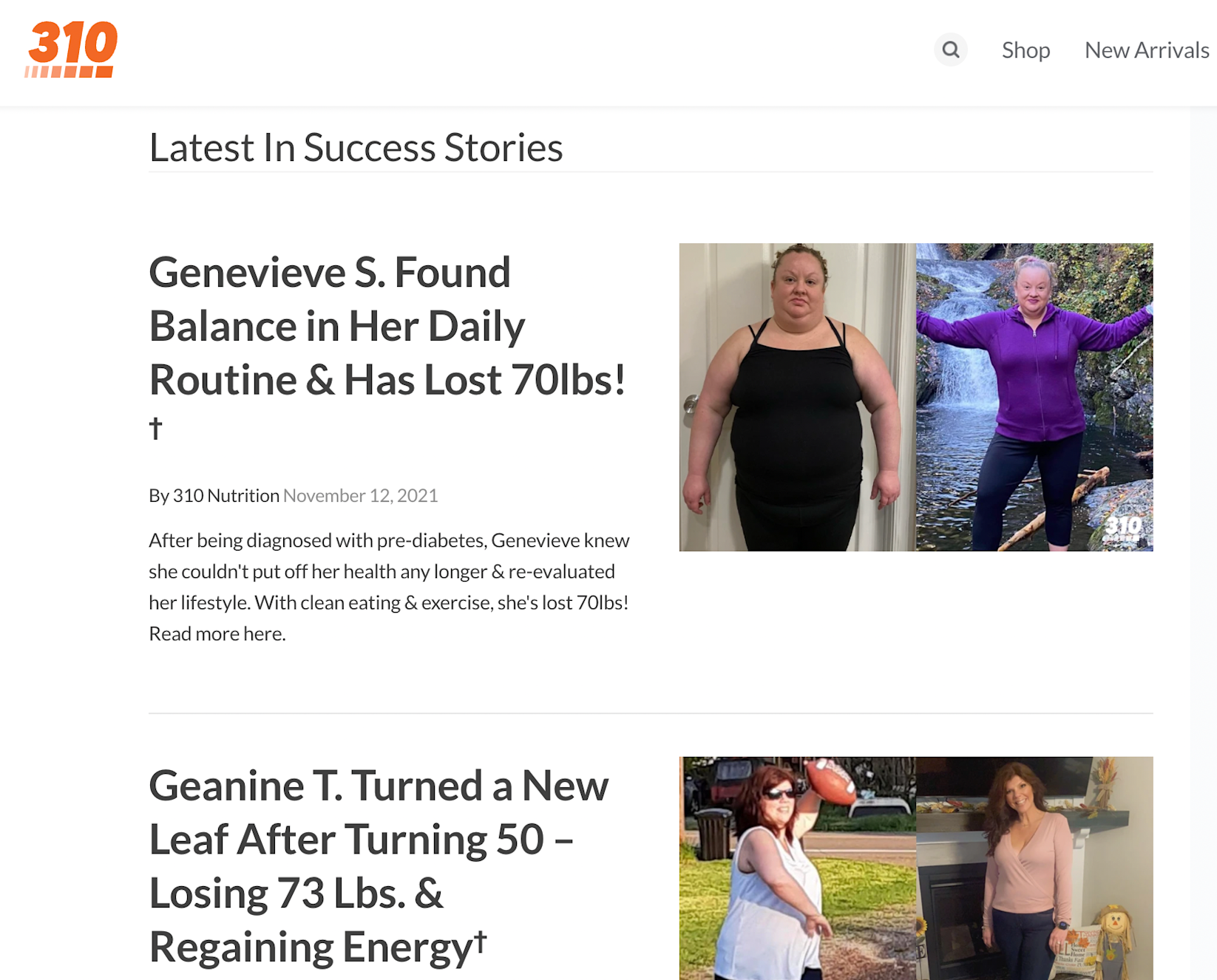
Reviews and UGC are a great way to motivate skeptical visitors. Fitness brands that can anticipate customers’ difficulties and address them with support from either internal sources or through their social community will see better results and better loyalty.
6. NOBULL: selling out midnight product launches
When you’re competing with worldwide brands like Nike, Reebok, and Adidas, you better bring your A-game. And that’s what fitness brandNO BULLcontinues to do.
Its brand manifesto is “For people who train hard with no excuses.”
Sure enough, when you’re selling out from regular midnight product launches, there is no excuse for site crashes and other issues.
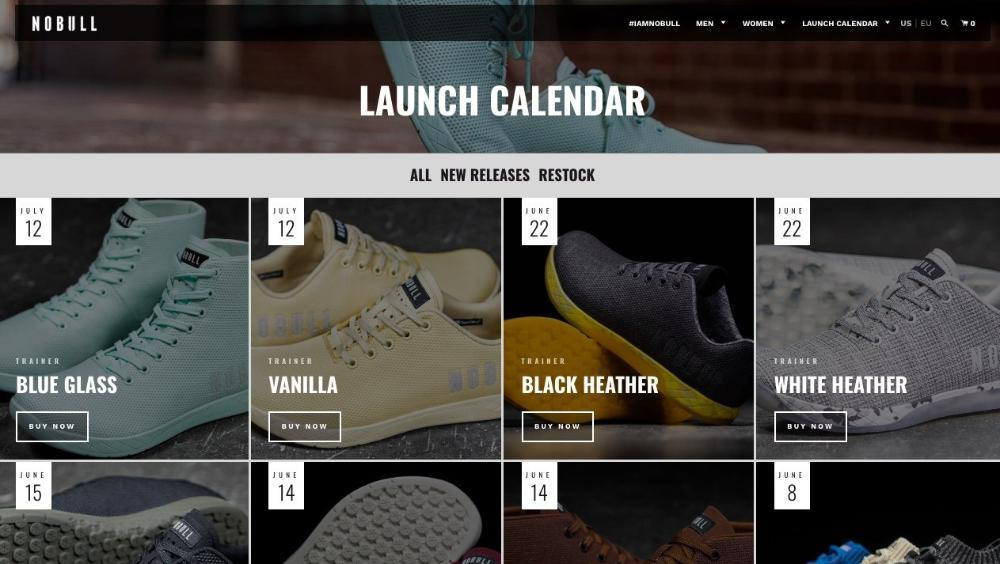
“We launch all of our products at midnight because right now demand greatly exceeds supply,” says NO BULL co-founder Marcus Wilson. “It’s a way to make sure our most loyal customers—those who are willing to show up and shop at midnight—are more likely to get what they want.”
Because of these loyal customers, sometimes the shoes still sell out before the midnight masses manage to check out.
As proven by NOBULL, using an ecommerce platform that can grow with your demand is imperative. The only thing that should prevent customers from getting your product is the supply—not a website that crashes.
7. Boxraw: automating the business to focus on the vision
Ben Ammana bootstrappedBoxrawwith the vision of changing the narrative of boxing as more than just “fighting with fists.” When he launched the company in 2017, Ben was a one-man show for nearly two years as he scrambled to grow.
As he slowly built the Boxraw team, he decided to invest in Shopify Plus in 2019. In 2020, the company hit £5.2 million in sales.
Today, the platform not only helps him onboard new employees quicker (an important function as he intends to double his 39-person team in 2022), but it also allows him to automate many of his sales and marketing efforts so his team can focus on the Boxraw foundation:Boxing is Love.
According to the Boxraw website, “Through the creation of boxing programs and gyms, [Boxraw] uses boxing as a mechanism to help children overcome social epidemics. We will change the world; nation by nation, glove by glove.”

Boxraw isn’t just outfitting successful boxers around the world; it’s also leveraging its ecommerce company to make a fundamental change for Liberia and beyond.
8. Women’s Best: provide localized experiences for international customers
Women’s Best—a brand focused on supplements and vitamins for women—has made an international name for itself by creating different ecommerce storefronts around the globe.
The brand offers 10 custom storefronts, each featuring Women’s Best products in the local language and currency.
What’s even more impressive is it’s extended itslocalization strategyto include Instagram: customers in Poland, Italy, and the Middle East can follow accounts in their language that link to each localized storefront.
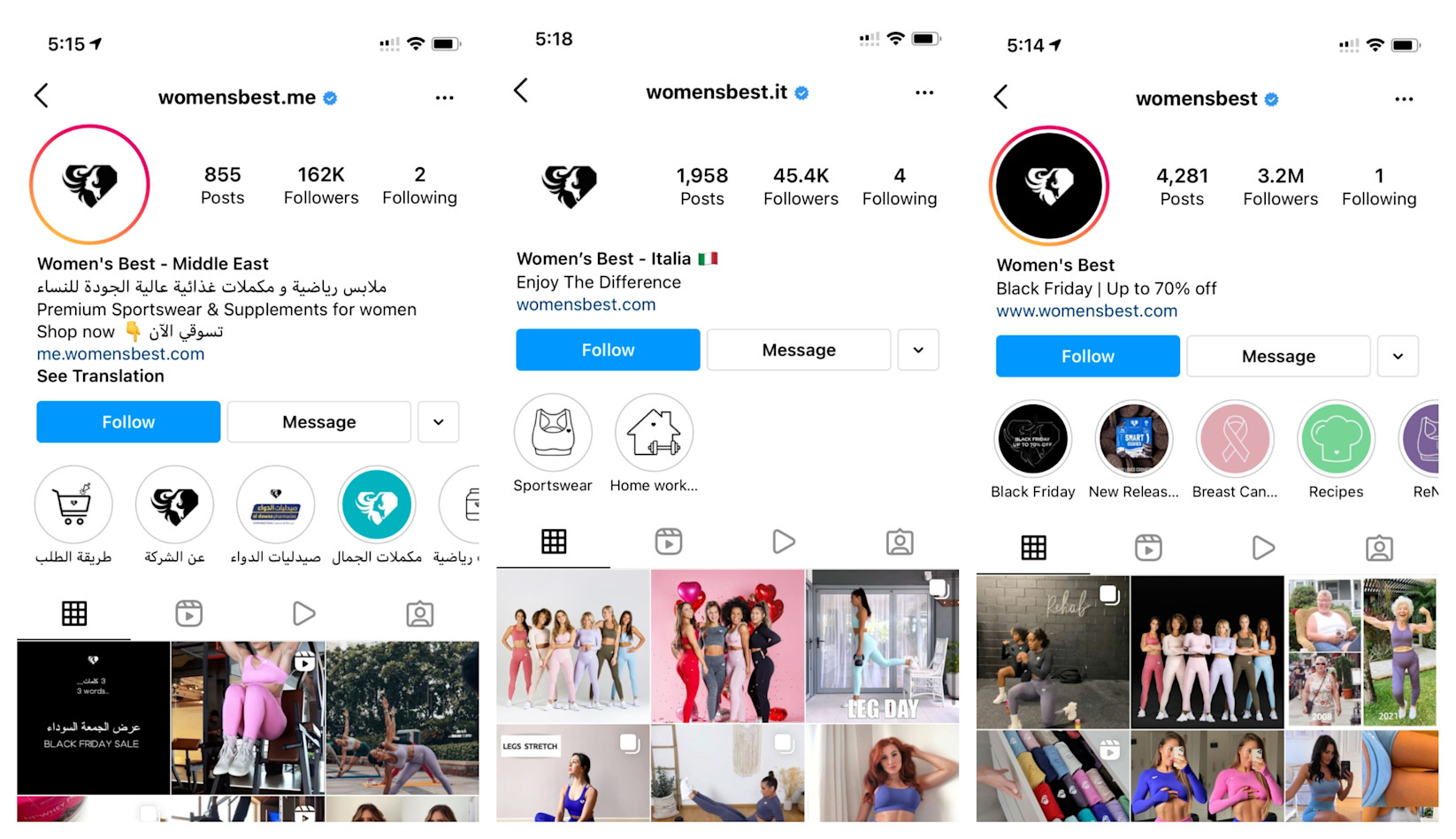
Women’s Best also offers a separate account for its apparel: Women’s Best Wear. By creating these targeted accounts, Women’s Best can build specific customer funnels based on customers’ locations or interests.
If your goal is to sell around the world, take note of the customer nuances that may impact how you interact with your audience. For Women’s Best, different Instagram accounts help satisfy those distinctions.
9. Campus Protein: targeting audiences to build communities
Campus Proteinwas founded by students, for students (hence the name). The supplement brand has since scaled beyond college campuses into a multi-million dollar operation, but it still targets college students through its messaging and marketing efforts.
Growing from one campus in 2010 to 300 by 2016, Campus Protein saw rapid growth through its Campus Rep program. Today, not only do reps make up to 12% commission, but through reps, Campus Protein has also been able to directly reach student populations—versus selling to them from generic store shelves.

Moreover, Campus Protein has also supported reps as they've started and grown their career—either at Campus Protein itself or through another full-time job.
This approach has allowed the brand to inadvertently build a loyal community of Campus Protein fans, ensuring that customers will make repeat purchasesandthat reps will benefit.
10. SweetLegs: simplicity makes sales
SweetLegs sells leggings to women of all shapes and sizes. But aside from an incredible, inclusive product, what sets the brand apart is the fact that it favorssimplicityover the complications of traditional enterprise ecommerce platforms.
In 2016, the SweetLegs website crashed on the most important shopping weekend of the year: Black Friday. In the aftermath, this multi-million-dollar brand decided it couldn’t face 2017’s holiday season exposed to the same risks.
So, it decided to re-platformone month before Black Friday.
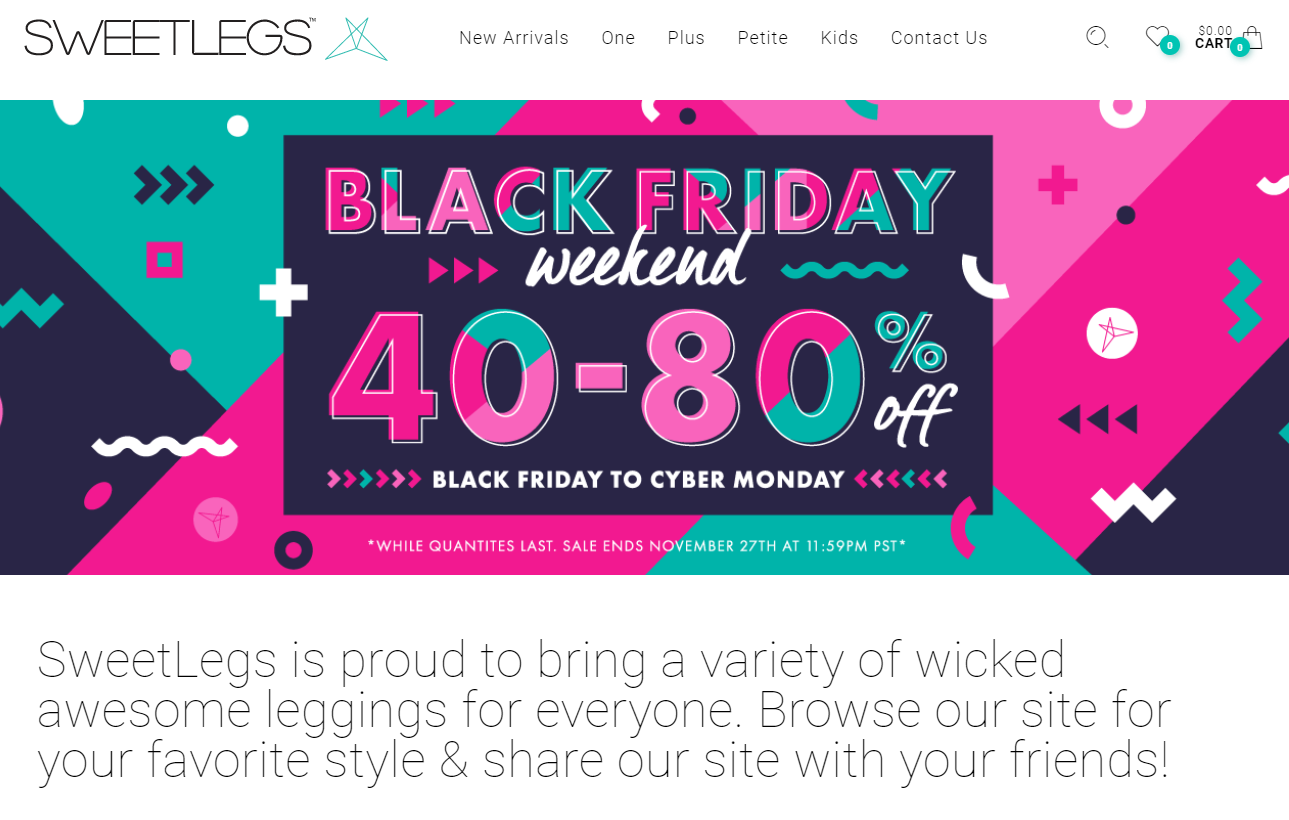
“On October 16, we picked a standard template, paid a firm to migrate our data, and were up and running by November 1,” says Chris Pafiolis, CEO of SweetLegs.
“With our craziest month to date—$2 million in sales, over 10,000 transactions, and insane amounts of traffic—we no longer worry about sending marketing emails in batches or crashing the site. We can truly focus on growing our business!”
Simplicity means you can spend more time taking care of what matters. Since then, SweetLegs has continued to grow and enjoy seamless transactions.
11. GuardLab: revolutionizing teeth, digitally speaking
你会不会觉得买口顾怎么样ard online? If I told you that athletes across the country—including from the New England Patriots, Toronto Blue Jays, and University of North Carolina basketball team—were doing it, would it change your mind?
Sports technology companyGuardLabis revolutionizing the way athletes buy mouth guards. It’s incorporated an online-to-offline (O2O) strategy that takes the worry out of the buying process.
To purchase a mouth guard, customers must submit a dental scan, either through an at-home kit or their local dentist. Athletes can also customize their mouth guard with their name, team logo, or country’s flag.
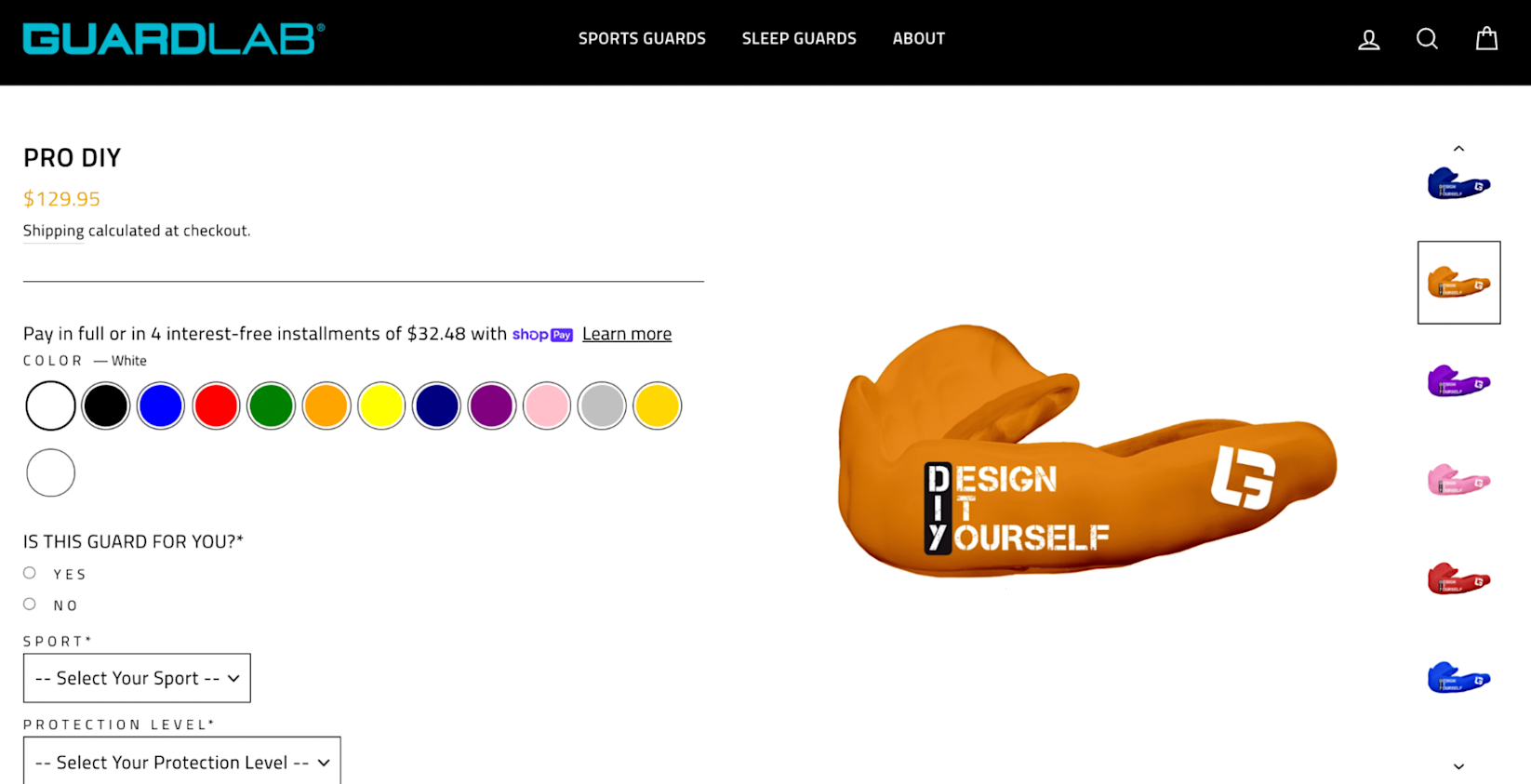
Better yet, GuardLab keeps every customer’s scan on file so athletes only have to submit a custom scan once.
If having O2O is part of your strategy, it’s critical you have the systems in place to ensure a seamless experience for customers. It’s also helpful to display customer reviews and testimonials to build trust with potential shoppers.
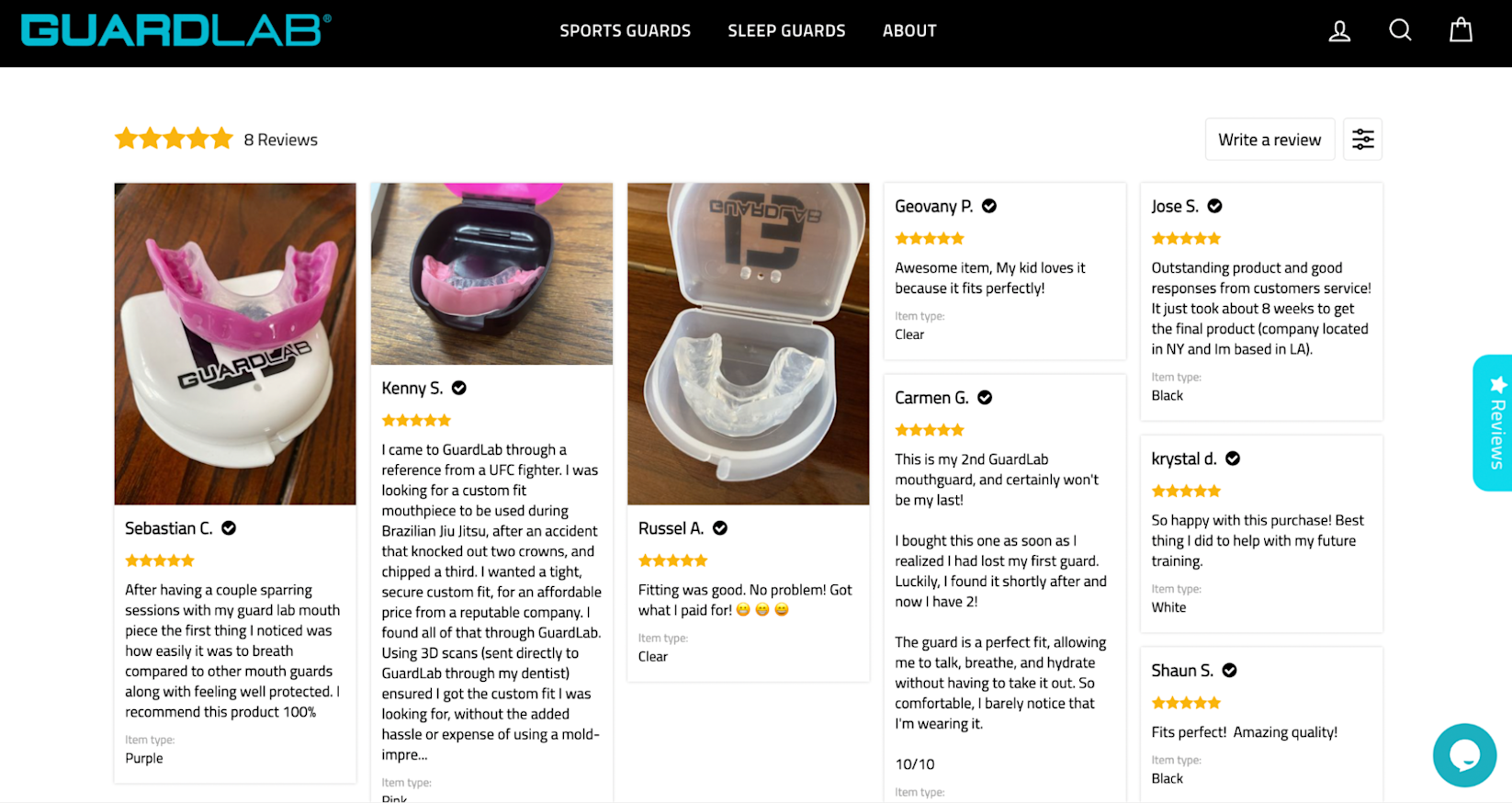
12. Fabletics: using customer data to its full potential
Fabletics has taken athleisure to a new level by offering customers a VIP subscription membership. These customers enjoy curated monthly outfit choices at a reduced cost.
Dustin Netral, Senior Vice President at Fabletics, says, “We use this information to project inventory. We can see past purchase behaviors and attribute a transaction.”
By asking new members seven targeted questions about their lifestyle and style preferences, as well as using their past purchases as predictors,Fableticscan personalize outfits for each member.
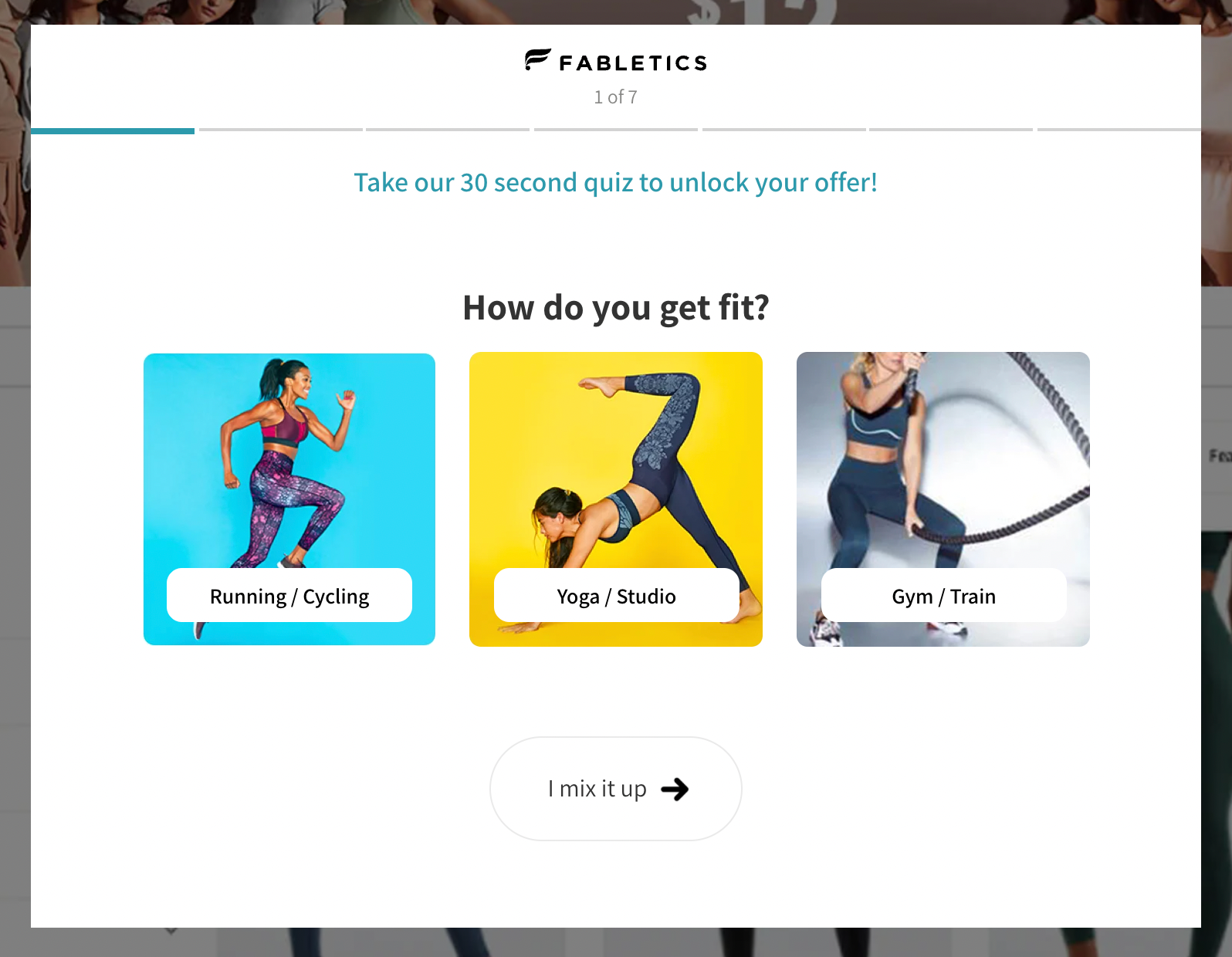
What’s more, by using its online data, the brand can enhance the offline experience for customers. It’s a win-win for both Fabletics and its fans.
In today’s online world, we have the technology to keep track of our clients’ likes and purchasing behaviors. With the proper permissions in place, using this information to improve a customer’s experience will result in the elusive yet oft-mentioned “surprise and delight” factor.
13. Active Truth: actively simplifying the back end of ecommerce
Active Truthwas founded on the premise that women deserve better from the activewear market. While working full-time jobs, founders Stevie and Nadia launched Active Truth with 100 pairs of tights in a plastic tub, a homemade website, and no marketing budget.
他们怎么能今天六full-time employees, a large warehouse, and a dedicated HQ? By investing in simple yet robust ecommerce solutions that allowed the company to focus on expanding its mission and vision.
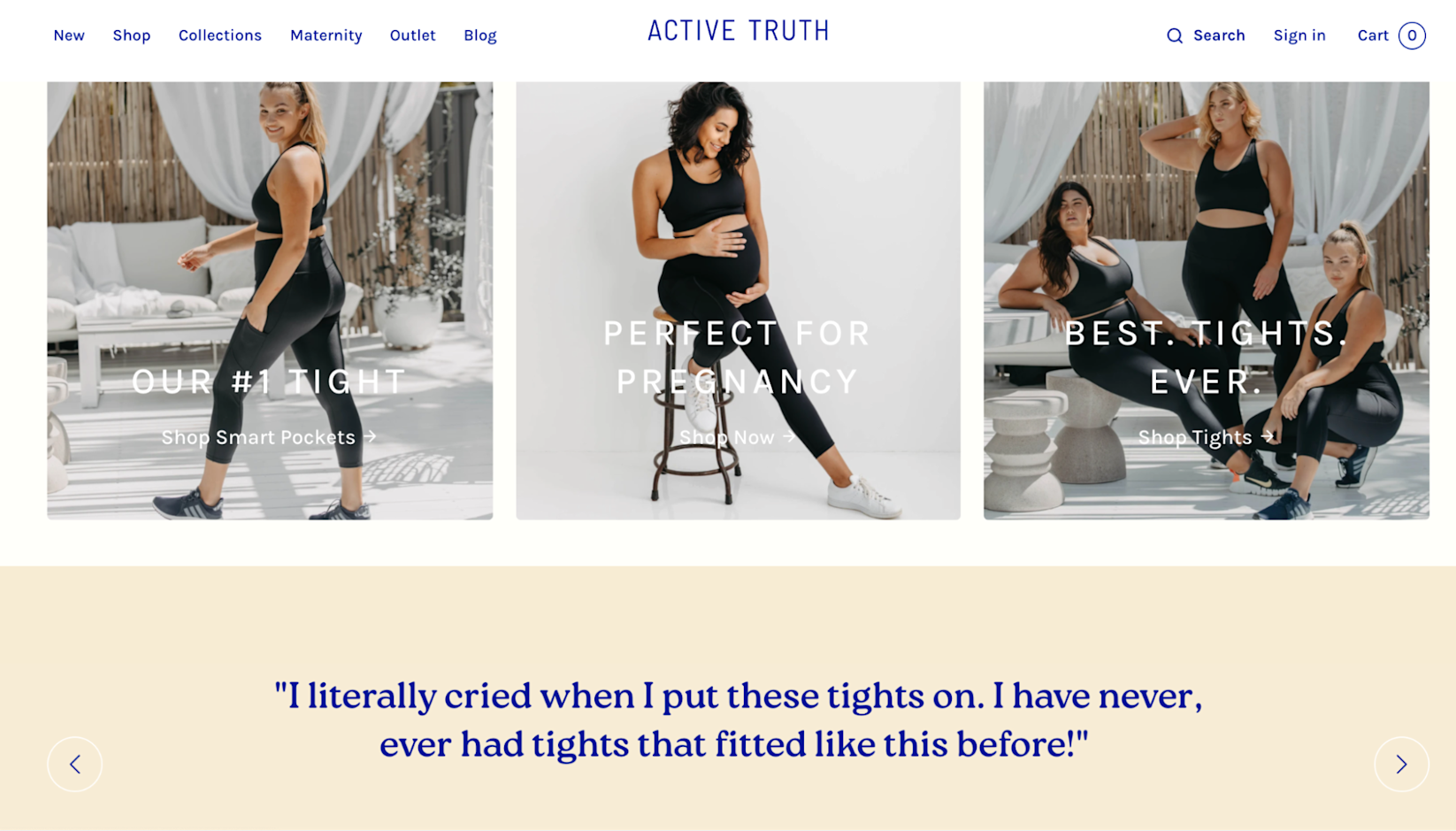
The Active Truth team was tired of managing the website at all hours of the day, so they sought a low code ecommerce platform—Shopify Plus. The move let Active Truth “set and forget” its operations, but this didn’t affect its performance.
In fact, once it replatformed, Active Truth’s conversion rate increased by nearly 50%.
Whether your fitness ecommerce brand is operating from a plastic tub or massive warehouse, a simple yet effective ecommerce platform can do wonders for your business.
14. Mava Sports: giving load times the one-two punch
Can a few seconds affect sales? Absolutely.
较慢的页面响应会导致更高的反弹rates and cart abandonment. Even a one-second lag on your page’s upload can result in 7% fewer sales. And if you’re pulling in $100,000 a day, that adds up fast.
For athletic companyMava Sports, that was unacceptable.
“You can have the best advertising, but if the people don’t wait for the page to load, it’s useless,” explains Vali Vetan, Mava Sports coding whiz.
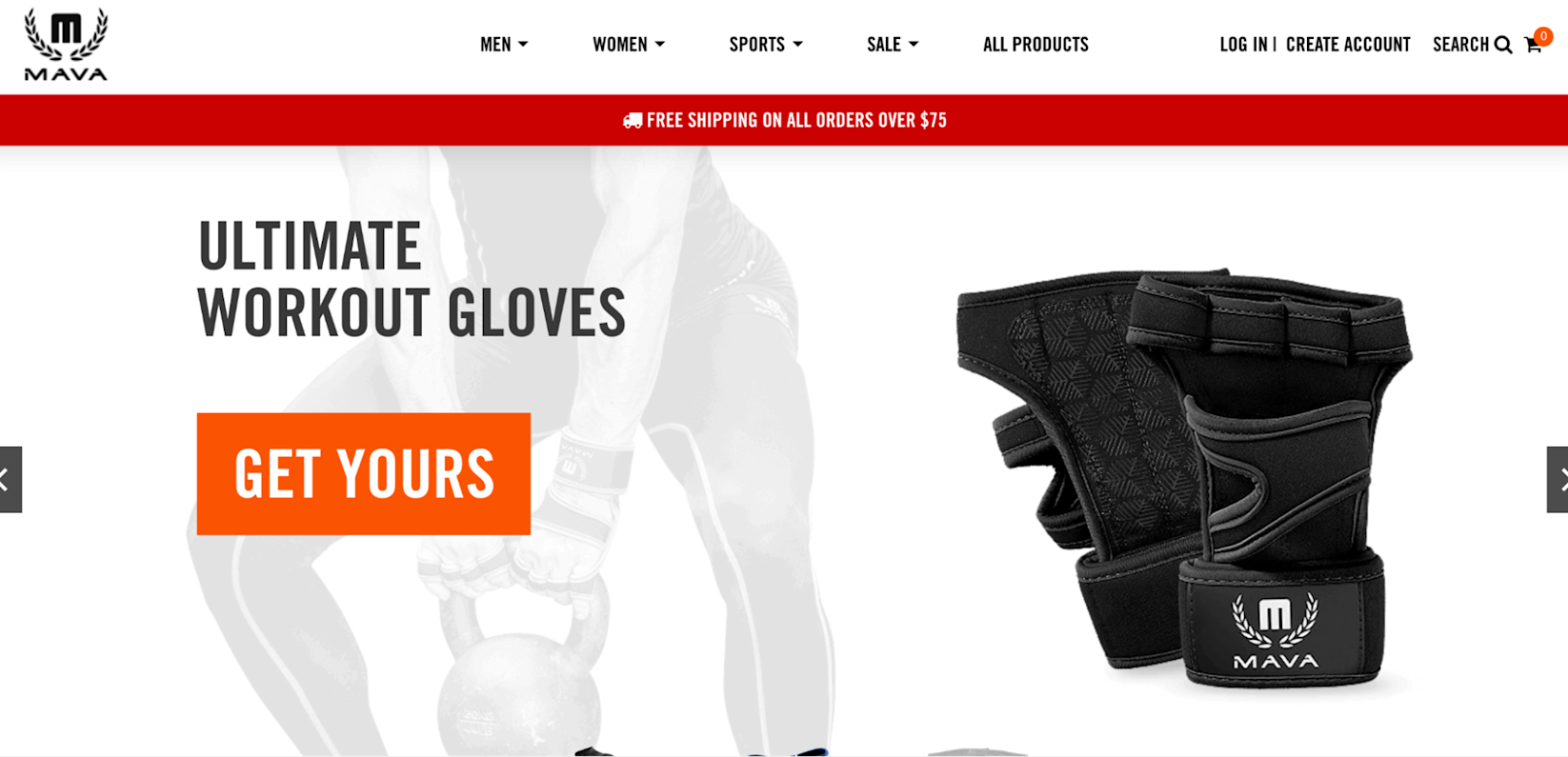
So, what did Mava Sports do about it? Vetan and his team removed as many non-essential apps and plug-ins without compromising the customer’s experience. They kept only the essential content and apps to load immediately, and using the LazyLoad script meant even those necessary items would only show once the page was rendered.
Thanks to all these tweaks, the Mava Sports website now loads five times faster. Having all the bells and whistles is nice, but if it comes at the cost of a faster site, is it worth it?
Understanding what’s critical to the user experience and removing what isn’t can help speed up your pages and make visitors stay longer.
15. Kayla Itsines: leaning into the raw, aspirational side of fitness
Kayla Itsinesis a worldwide fitness phenomenon. She was voted one ofTime’s 30 Most Influential People on the Internet in 2016 and madeAustralia's Young Richlist in 2021.

In 2008, Itsines became a gym trainer when she finished school. She worked with women who all had the same fitness goals: slim down, but don’t bulk up. When the machine-based classes she was leading didn’t seem to do the trick, she switched to aerobics. Women loved the classes, and Itsines saw way better results.
Friends began asking Itsines for help with nutrition and fitness. In return, Itsines wanted before and after pics to share on Instagram. She got noticed by women all over the world who started asking Itsines for guidance. From there, she built her brand into the $160 million empire it is today.
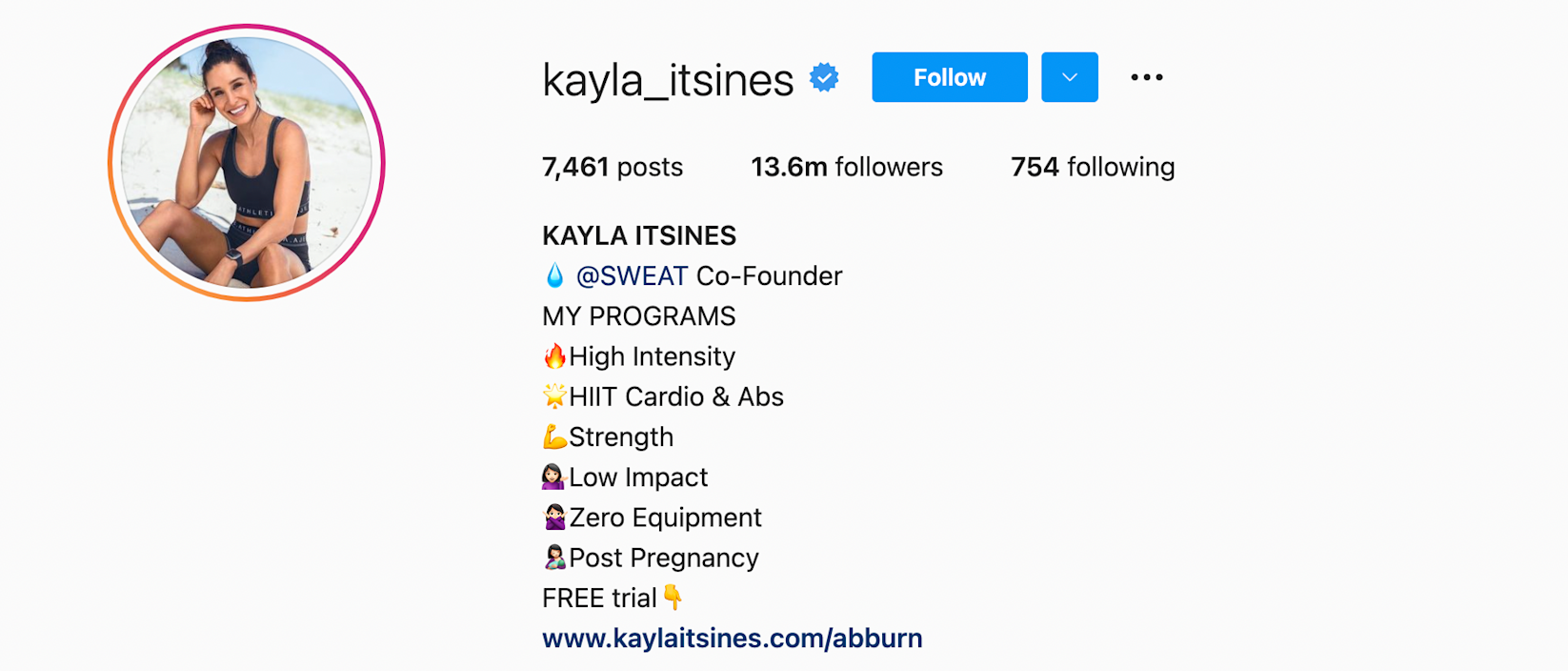
Her almost 14 million followers on Instagram and close to 30 million on Facebook didn’t happen overnight.
她专注于健身、有抱负的一面nd it works becauserealwomen in therealworld began showing their results and spreading the Itsines gospel.
另一个值得注意的策略?她的产品页面have a “Recommended for you” section to help guide customers and drive upsell. These methods work best when you have a loyal customer base that trusts your recommendations.
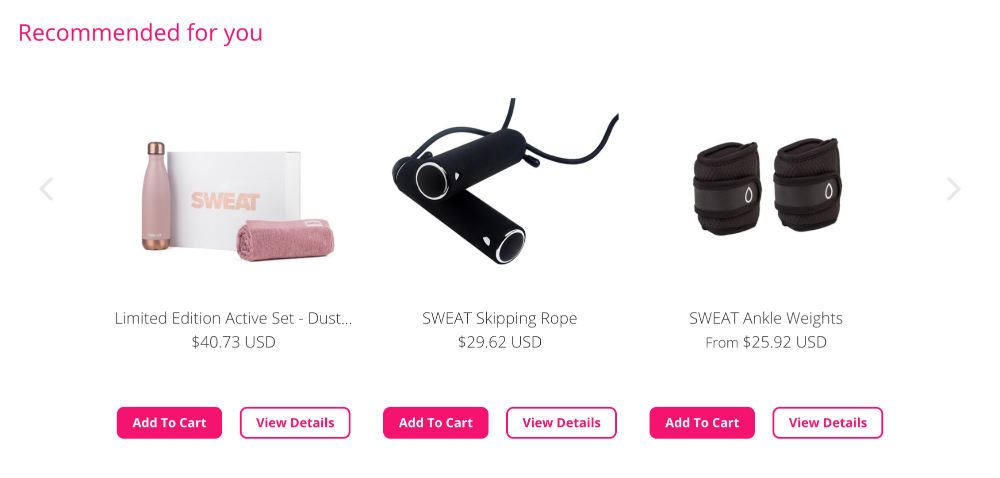
Customers like knowing what to expect from brands, and so consistency helps move you forward. The takeaways from Itsines are to be true to yourself and your brand.
Fitness ecommerce: bigger, better, faster
These standout fitness ecommerce websites have shown us that:
- Using customer data helps inform decisions
- Giving your users an incentive to stay motivated helps build loyalty
- Unifying O2O strategies helps solidify connections
- Leveraging social media for a global marketplace helps reach customers worldwide
The adage of thinking outside the box (or in this case, thinking outside the gym) isn’t dead just yet.
